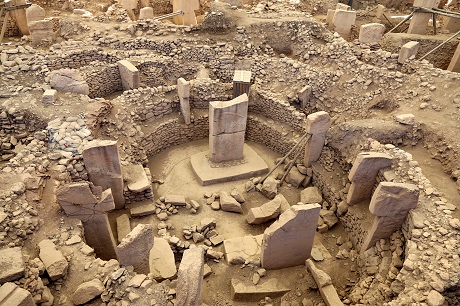ERBIL, Kurdistan Region -- What is believed to be the first holy site constructed by humans, found in Turkey’s Kurdistan, has been added to UNESCO’s world heritage list.
About 6,000 years before Stonehenge and the invention of writing and 6,500 years before the Egyptian pyramids, there was Gobekli Tepe.
Aged between 9,600 and 8,200 BC, Gobekli Tepe was built by hunter-gatherers in the Germus mountains of southeast Turkey. The site is located a few kilometres outside of Sanliurfa.
“This site presents monumental circular and rectangular megalithic structures, interpreted as enclosures,” stated UNESCO in a press release on Sunday.
Locals have dubbed the site Potbelly Hill.
“It is likely that these monuments were used in connection with rituals, probably of a funerary nature,” UNESCO stated.
“Distinctive T-shaped pillars are carved with images of wild animals, providing insight into the way of life and beliefs of people living in Upper Mesopotamia about 11,500 years ago,” the world heritage organization added.
At least 50 massive carved pillars - the tallest measure over 4.5 metres and weigh in at between seven and ten tons - set within concentric rings were constructed and arranged before the invention of metal tools.
The site was first examined in the 1960’s but its significance was not realized until the German archaeologist Klaus Schmidt was surveying the region in 1994.
“Only man could have created something like this,” he told The Smithsonian in a 2008 interview of his first sighting of the gently-rounded hill that rises out of the surrounding plateau. “It was clear right away this was a gigantic Stone Age site.”
Schmidt passed away in 2014.
Gobekli Tepe reopened to visitors in April. It had been closed for restoration work.
Construction of a walkway and roof drew criticism in March.
“The construction work for the visitor center, as reflected in the media, looks like a disaster,” warned archaeologist Nezih Başgelen, Hurriyet Daily News reported at the time.
“They should have moved very sensitively in the protection zone but we can see heavy construction equipment used on the site. It is very worrying that the extraordinary Neolithic remains and the round temple site at the entrance have been exposed to such action. It is unacceptable that such careless construction work has damaged this extraordinary archaeological site.”

About 6,000 years before Stonehenge and the invention of writing and 6,500 years before the Egyptian pyramids, there was Gobekli Tepe.
Aged between 9,600 and 8,200 BC, Gobekli Tepe was built by hunter-gatherers in the Germus mountains of southeast Turkey. The site is located a few kilometres outside of Sanliurfa.
“This site presents monumental circular and rectangular megalithic structures, interpreted as enclosures,” stated UNESCO in a press release on Sunday.
Locals have dubbed the site Potbelly Hill.
“It is likely that these monuments were used in connection with rituals, probably of a funerary nature,” UNESCO stated.
“Distinctive T-shaped pillars are carved with images of wild animals, providing insight into the way of life and beliefs of people living in Upper Mesopotamia about 11,500 years ago,” the world heritage organization added.
At least 50 massive carved pillars - the tallest measure over 4.5 metres and weigh in at between seven and ten tons - set within concentric rings were constructed and arranged before the invention of metal tools.
The site was first examined in the 1960’s but its significance was not realized until the German archaeologist Klaus Schmidt was surveying the region in 1994.
“Only man could have created something like this,” he told The Smithsonian in a 2008 interview of his first sighting of the gently-rounded hill that rises out of the surrounding plateau. “It was clear right away this was a gigantic Stone Age site.”
Schmidt passed away in 2014.
Gobekli Tepe reopened to visitors in April. It had been closed for restoration work.
Construction of a walkway and roof drew criticism in March.
“The construction work for the visitor center, as reflected in the media, looks like a disaster,” warned archaeologist Nezih Başgelen, Hurriyet Daily News reported at the time.
“They should have moved very sensitively in the protection zone but we can see heavy construction equipment used on the site. It is very worrying that the extraordinary Neolithic remains and the round temple site at the entrance have been exposed to such action. It is unacceptable that such careless construction work has damaged this extraordinary archaeological site.”




Comments
Rudaw moderates all comments submitted on our website. We welcome comments which are relevant to the article and encourage further discussion about the issues that matter to you. We also welcome constructive criticism about Rudaw.
To be approved for publication, however, your comments must meet our community guidelines.
We will not tolerate the following: profanity, threats, personal attacks, vulgarity, abuse (such as sexism, racism, homophobia or xenophobia), or commercial or personal promotion.
Comments that do not meet our guidelines will be rejected. Comments are not edited – they are either approved or rejected.
Post a comment